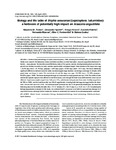Please use this identifier to cite or link to this item:
http://www.alice.cnptia.embrapa.br/alice/handle/doc/974006Full metadata record
| DC Field | Value | Language |
|---|---|---|
| dc.contributor.author | ZENKER, M. M. | pt_BR |
| dc.contributor.author | SPECHT, A. | pt_BR |
| dc.contributor.author | FRONZA, E. | pt_BR |
| dc.contributor.author | POLETTO, G. | pt_BR |
| dc.contributor.author | MARCON, F. | pt_BR |
| dc.contributor.author | FORMENTINI, A. C. | pt_BR |
| dc.contributor.author | GEDOZ, M. | pt_BR |
| dc.date.accessioned | 2013-12-16T11:11:11Z | pt_BR |
| dc.date.available | 2013-12-16T11:11:11Z | pt_BR |
| dc.date.created | 2013-12-16 | pt_BR |
| dc.date.issued | 2013 | pt_BR |
| dc.identifier.citation | Zoologia, Curitiba, v. 30, n. 2, p. 143-150, April 2013. | pt_BR |
| dc.identifier.uri | http://www.alice.cnptia.embrapa.br/alice/handle/doc/974006 | pt_BR |
| dc.description | The life-history and biology of Dirphia araucariae Jones, 1908, including its life fertility table, are here described. Moths were reared in the laboratory under controlled conditions on their host plant, Araucaria angustifolia (Bertoloni) O. Kuntze ? Araucariaceae. We describe several life-history traits of the species, namely: developmental period, survival rate, growth rate, fertility, fecundity, sex ratio, cephalic capsule width, and pupal weight. Mean duration of life stages were: egg = 26.78 days; larva = 61.78 days; repupa = 6.85 days; pupa = 62.46 days; adult = 8.37 days. We found statistically significant differences between sexes for adult, larval and pupal stage duration; larval stage was longer in females while pupal stage was longer in males. The survival rate of each life stage was: egg = 96.18%; larva = 95.38%; prepupa = 83.87%; pupa = 100%. The larvae developed through six instars and the mean growth rate was 1.418. The width of male and female cephalic capsules were different in last three instars, even though the total mean width between sexes was not different. Pupal mean weight ranged from 2.40 g to 4.79 g, with females being heavier than males. Fertility ranged from 66.78% to 100%, and the total fecundity was 358.45 eggs/female, including both laid eggs and eggs held in the abdomen. The sex ratio was 0.50 ± 0.05. The estimated biotic potential was 48731.08 specimens/female/year. We found the following values for the fertility life table: (Ro) = 117.21 females; (T) = 162.75 days; (rm) = 0.21; ( ) = 1.23. Considering the biological parameters evaluated in this study, we conclude that D. araucariae is not able to cause primary damage in A. angustifolia forests, although further studies are needed to understand the reasons for occasional population outbreaks. | pt_BR |
| dc.language.iso | eng | eng |
| dc.rights | openAccess | eng |
| dc.subject | Historia de vida | pt_BR |
| dc.subject | Lepidotero | pt_BR |
| dc.title | Biology and life table of Dirphia araucariae (Lepidoptera: Saturniidae): a herbivore of potentially high impact on Araucaria angustifolia. | pt_BR |
| dc.type | Artigo de periódico | pt_BR |
| dc.date.updated | 2013-12-16T11:11:11Z | pt_BR |
| dc.subject.thesagro | Araucária Angustifólia | pt_BR |
| dc.subject.thesagro | Pinheiro do Paraná | pt_BR |
| dc.subject.nalthesaurus | Lepidoptera | pt_BR |
| dc.subject.nalthesaurus | Life history | pt_BR |
| dc.subject.nalthesaurus | Brazil | pt_BR |
| riaa.ainfo.id | 974006 | pt_BR |
| riaa.ainfo.lastupdate | 2013-12-16 | pt_BR |
| dc.identifier.doi | http://dx.doi.org/10.1590/S1984-46702013000200004 | pt_BR |
| dc.contributor.institution | MAURÍCIO M. ZENKER, UNIVERSIDADE FEDERAL DO PARANÁ; ALEXANDRE SPECHT, CPAC; EDEGAR FRONZA, UNIVERSIDADE DE CAXIAS DO SUL; GRAZIELA POLETTO, UNIVERSIDADE DE CAXIAS DO SUL; FERNANDA MARCON, UNIVERSIDADE DE CAXIAS DO SUL; ALINE C. FORMENTINI, UNIVERSIDADE DE CAXIAS DO SUL; MATEUS GEDOZ, UNIVERSIDADE DE CAXIAS DO SUL. | pt_BR |
| Appears in Collections: | Artigo em periódico indexado (CPAC)  | |










